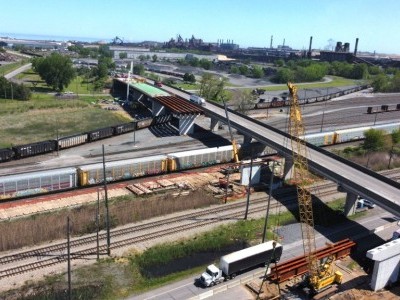North Carolina Ports makes history, welcomes largest container ship to the Port of Wilmington
May 21, 2020The North Carolina State Ports Authority made history Wednesday as the MV Hyundai Hope sailed in to the Port of Wilmington. The MV Hyundai Hope has a carrying capacity of nearly 14,000 TEUs (twenty-foot equivalent units) and is one of the largest container ships calling on the United States East Coast.

“This is a monumental milestone for North Carolina Ports, the Port of Wilmington and the entire state of North Carolina. This has been years in the making and seeing our hard work and dedication come to fruition with the arrival of the MV Hyundai Hope is truly something to celebrate,” said Paul J. Cozza, Executive Director, North Carolina Ports. “This would not have been possible without the support of our many partners at the local, state and federal levels as well as funding from the North Carolina General Assembly.”
“Our ports are an important asset for connecting North Carolina to opportunities around the globe. Welcoming this ship shows our commitment to supporting North Carolina’s ports and overall economy is paying off and keeping our state globally competitive,” added Robert A. Wicker, Chairman, North Carolina Ports Board of Directors.
The arrival of the MV Hyundai Hope highlights North Carolina Ports’ commitment to its more than $200 million capital improvements plan. Enhancing the Port of Wilmington’s infrastructure to support the largest vessels calling on East Coast ports has long been a focal point of this initiative.
“Our team and Board of Directors recognized the importance of improving our infrastructure to support the growing vessels able to reach the United States following the expansion of the Panama Canal in 2016. Since then, we have been working tirelessly to modernize our facilities in preparation of this historic moment,” said Brian E. Clark, Chief Operating Officer, North Carolina Ports.
The arrival of the MV Hyundai Hope follows the completion of four major projects aimed at improving access for 14,000-TEU container ships to the Port of Wilmington. Earlier this year, NC Ports completed phase two of its turning basin expansion project; opened 2,600 contiguous feet of container berth space; and completed an air draft improvement project which increased the air draft over the Cape Fear River. Additionally, the Ports Authority welcomed three neo-Panamax cranes in 2018 and 2019 specifically designed to work ultra-large container vessels (ULCVs).
“This is proof positive that we are big ship ready and capable of handling some of the largest container vessels calling East Coast ports today,” said Hans C.E. Bean, North Carolina Ports Chief Commercial Officer. “The arrival of a ship of this magnitude to the Port of Wilmington signals to our customers that we are ready to support their growing business needs today and in the future.”
The MV Hyundai Hope is operated by HMM in partnership with THE Alliance linking Asia and South America to Wilmington. On April 1, 2020, HMM officially joined THE Alliance which is made up of three additional ocean carriers: Hapag-Lloyd, Yang Ming and Ocean Network Express (ONE).
Similar Stories

Jeffersonville port delivers record road salt shipments to Greater Louisville area during recent winter storms
View ArticleNC Ports Notice: Holiday Schedule Notice Martin Luther King Jr. Day
The Port of Wilmington Container Gate (South Gate) and the Charlotte Inland Port (CIP) will operate on a reduced schedule on Monday, January 20: 8 AM-12 PM and 1 PM-5…
View Article
Port of Long Beach’s Cordero hails ‘Green Port’ achievements
View Article
Port of San Diego accepts $5 million grant from the San Diego County Air Pollution Control District for clean air project
View Article
Adriatic Gate Container Terminal welcomes Bora Med Service
View Article
Savannah gets India cargo to market up to eight days faster
View ArticleGet the most up-to-date trending news!
SubscribeIndustry updates and weekly newsletter direct to your inbox!





